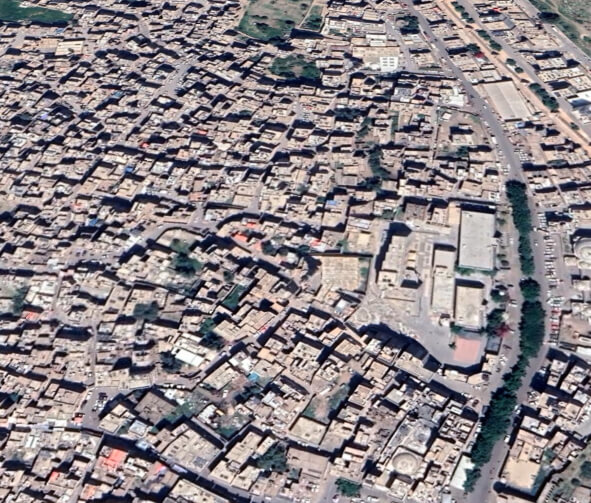
Ṣalāḥ al-Dīn Mosque – Old Ṣan‘ā’
مسجد صلاح الدين- صنعاء القديم ة
Monument description
Salahaldin Mosque in the City of Sana‘a has been built in the middle of the 8th century by Muhammad bin Ali bin Mansour bin Yahya bin Mansour bin Al-Mufaddal bin Al-Hajjaj, who died in the year 793 AH. The architecture of his Minaret is attributed to Minister Sinan Pasha in the early 11th century AH, according to the text of its foundation in the wall of the Minaret above the entrance, while the building of its extension is attributed to Sheikh Hassan Bin Muhammad al-Shatibi in the year 1128 AH.

Architectural and cultural value
Construction style and built date: The layout of the Mosque came in the style of mosques, which consist of a Prayer Hall, consisting of tiles, with a flat roof covered with wooden beams resting directly on the capitals of stone columns and arches. The construction of the Mosque dates back to the second half of the 8th century AH (793 AH).
Components of the Mosque: The Mosque consists of a rectangular area, and this space includes the architectural components of the Mosque and its annexes, which are: the Prayer Hall, the Minaret, the domed Mausoleum and the rooms adjacent to it, the outer open court, the external Iwan overlooking the open court, the sanctuaries, bathrooms and the School. The monument area is 1103 m2.
- Justifications for intervention:
- 1 – Neglecting the competent authorities in carrying out periodic restoration work due to the lack of budgets for the repairs.
2 – Preserving the monument from disappearance and stopping the damage caused to the monument from expanding.
3 – Restoration of the damage to the mosque resulting from the flight strikes of the eastern part of the old city of Sana’a.
4 – Contribute to the restoration of damaged monuments in a proper manner in order to keep Old Sana’a on the UNESCO list.
- Monument conditions:
- The monument is generally in good preservation condition, however there are some obvious signs of damage and some of them need urgent intervention to maintain the building.
1. Erosion of The foundation materials.
2. Damage to the external walls, erosion of bonding materials and coverings, and the usege of cement which is contraray to the historical buildings.
3. Erosion the peak of the roof on the southeast side of the mosque.
4. Damage to the main gate of the minaret with damage to some parts of itself.
5. Erosion of the Qudad and plaster layer in the belt around the minaret.
6. The use of modern building materials such as iron doors. damage to the windows and ceilings, and Qamariah and different damage to the palster and Qudad layers and Norah layer.
7. Distortion of historical doors using oil paint.
8. Using modern building materials that do not conform to the prevailing pattern in the mosque.
9. Using paint on the walls of the outer court.
10. Damage to decorations, engravings and wall scripts and painting them with oil paints that obliterate some parts of them.
- Treatment:
- – Remove and rebuilding of the damaged parts from the different parts of the mosque and using materials identical to the old materials, whether bricks, stones or others, and Complete any missing parts.
– Cleaning the decorative inscriptions in the different parts of the mosque, removing the oil paint, completing any dilapidated parts and deducing them through the decorations adjacent to them.
– Restoration of the Qudad layer of the mosque in its various areas and complete the missing parts of it.
– Restoration of historical doors and windows, restoration of al-Qamariya, along with replacement of modern, distorted materials in doors and windows with materials identical to historical building materials.
– Cleaning the stones and removing the paint that deform and distorts the architectural character of the mosque.

Countries








